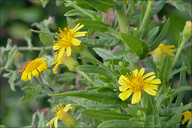|
|
click photo for larger file

Dittrichia viscosa
Samphire
|
Photographer: Dr. Amadej Trnkoczy
ID: 0000 0000 1017 1392 (2017-10-18)Copyright © 2017 Dr. Amadej Trnkoczy
|
|
INFORMATION PROVIDED WITH THE PHOTO
|
date of photo Sep 1, 2017
latitude 44.83885 longitude 14.73626
View on Google Maps.
location
Island Rab, northeast part of the island, next to dirt road south of Dubac bay, Kvarner bay, Adriatic Sea (Rijeka region, Croatia)notes Slo.: leplivi oman, lepljiva ditrihovka - syn.: Erigeron viscosus L., Inula viscosa (L.) Aiton, Jacobaea viscosa (L.) Merino - Habitat: Dirt road side and dry grassland, moderately inclined hill side, north aspect; sandstone ground; full sun, dry place; elevation 75 m (190 feet); average precipitations ~ 1.000 mm/year, average temperature 13-14 deg C, (Sub)Mediterranean phytogeographical region. Substratum: sandy soil. Comment: Dittrichia viscosa is also one of many, many yellow flowering members of Daisy (Asteraceae = Compositae) family. It is distributed all around Mediterranean Sea. Not really an attractive plant for photography but once a popular medical plant, particularly esteemed in south part of Mediterranean and among Arab nations. Hardly know outside its native Mediterranean region the plant has been regarded for thousands of years as one of the most effective medical plant of the region. It is mentioned already in Bible's Old Testament. In the first century it was in broad use and Roman polyhistor Pliny the Elder (Gaius Plinius Secundus) wrote a detailed description and use of the plant. In 16th century it was officially used by Swiss military to heal wounds. Today it is still cultivated in Israel. It was used in very broad spectrum of ailments from gum disorder to hemorrhoids, wounds treatment, joints pain, respiratory problems, diabetes and more. The species is relatively easy to recognize by its stout, pyramidal growth of individual flowering stalks, numerous glandulous hair on all parts of the plant, which make the whole plant sticky, and very late blooming time. Hence it is one of the most important sources of honey for bees and other insects during the winter. Ref.: (1) D. Aeschimann, K. Lauber, D.M. Moser, J.P. Theurillat, Flora Alpina, Vol. 2., Haupt (2004), p 462. (2) http://www.inulav.com/Inula_Viscosa.html (accessed Oct. 15. 2017) (3) A. Martinči et all., Mala Flora Slovenije (Flora of Slovenia - Key) (in Slovenian), Tehnična Založba Slovenije (2007), p 651. (4) I. Schӧnfelder, P. Schӧnfelder, Kosmos Atlas Mittelmeer- und Kanarenflora, Kosmos, (2002), p 216.camera Nikon D700 / Nikkor Micro 105mm/f2.8
contributor's ID # Bot_1085/DSC8828 photo category: Plant - annual/perennial
|
MORE INFORMATION ABOUT THIS PLANT
|
| common names
Samphire (photographer)
View all photos in CalPhotos of Dittrichia viscosa Check Google Images for Dittrichia viscosa |
|
The photographer's identification Dittrichia viscosa has not been reviewed. Click here to review or comment on the identification. |
|
Using this photo The thumbnail photo (128x192 pixels) on this page may be freely used for personal or academic purposes without prior permission under the Fair Use provisions of US copyright law as long as the photo is clearly credited with © 2017 Dr. Amadej Trnkoczy.
For other uses, or if you have questions, contact Dr. Amadej Trnkoczy amadej.trnkoczy[AT]siol.net. (Replace the [AT] with the @ symbol before sending an email.) |
|
|
